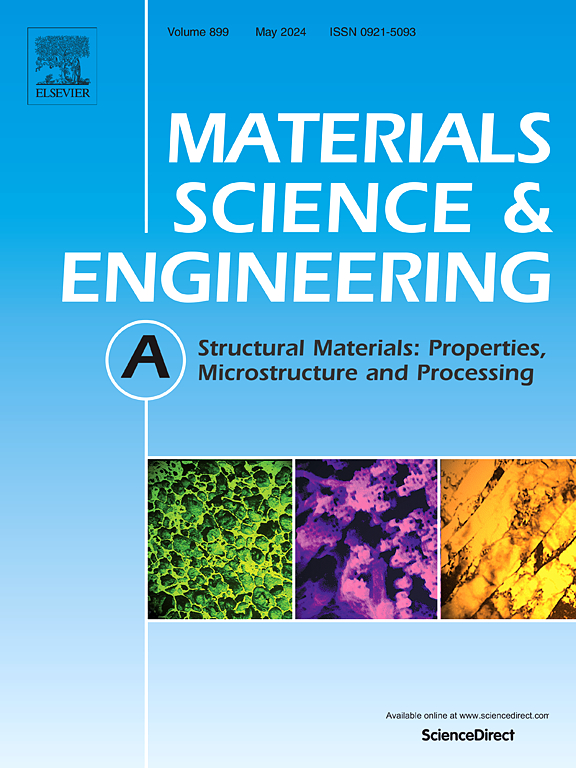利用双边界工程克服锆材料的强度-延性权衡
IF 7
2区 材料科学
Q1 MATERIALS SCIENCE, MULTIDISCIPLINARY
引用次数: 0
摘要
通过微结构设计来调整金属的强度和延展性一直是一个长期的努力。在这里,我们报告了通过一种新的多轴低温锻造(MACF)工艺在锆中发展出分层超细孪晶组织。Zr的MACF形成致密和细密的拉伸孪晶{101¯2}<;101¯1>;(T-1)和{112形式1}⟨1形式1形式26⟩(T-2)在粗糙和等轴颗粒内。与粗晶相比较,这种微观组织表现出显著的强度、应变硬化率和延展性的增强。在不影响材料延展性的情况下,屈服强度和极限抗拉强度分别提高了26%和30%。强度和应变硬化的提高源于较硬的<;c+a>;滑移体系及其与细小孪晶界的相互作用。值得注意的是,在室温变形过程中,细晶T-2孪晶的生长有助于增加延展性,而粗晶锆则没有。晶体塑性模拟表明,锥体<;c+a>;T-2孪晶中的滑移是棱柱体滑移的两倍;滑移,导致T-2孪晶提高应变硬化率。随后在500℃下对MACF Zr进行热处理,消除了孪晶界周围的弹性变形,因此拉伸应变导致应力辅助的孪晶界更容易迁移。这导致应变硬化速率降低。结果表明,在hcp金属中,这些典型的非共格拉伸孪晶周围的位错亚结构对其应变硬化行为起着至关重要的作用。本文章由计算机程序翻译,如有差异,请以英文原文为准。
Overcoming the strength-ductility trade-off in zirconium using twin boundary engineering
Tailoring the strength and ductility of metals through microstructural design has been a longstanding endeavour. Here, we report the development of a hierarchical ultrafine twinned microstructure in zirconium via a novel multi-axial cryo-forging (MACF) process. MACF of Zr resulted in the formation of dense and fine tensile twins, (T-1) and (T-2) within coarse and equiaxed grains. This microstructure exhibited a remarkable combination of enhanced strength, strain-hardening rate, and ductility, compared to its coarse-grained counterpart. The yield strength and ultimate tensile strength increased by up to 26 % and 30 %, respectively, without compromising material ductility. The improved strength and strain-hardening stemmed from the activation of the harder <c+a> slip system and its consequent interaction with the fine twin boundaries. Notably, the growth of fine T-2 twins during ambient temperature deformation, absent in coarse-grained zirconium, contributed to additional ductility. Crystal plasticity simulations reveal that the activity of pyramidal <c+a> slip within T-2 twins is twice that of prismatic <a> slip, leading to an enhanced strain-hardening rate contributed by the T-2 twins. Subsequent heat treatment of MACF Zr at 500 °C relieved the elastic distortions around twin boundaries, and hence tensile straining led to stress-assisted easier migration of pre-existing twin boundaries. This resulted in a lowering of the strain-hardening rates. It was shown that the dislocation substructure around these typically incoherent tensile twins in hcp metals plays a crucial role in their strain-hardening behaviour.
求助全文
通过发布文献求助,成功后即可免费获取论文全文。
去求助
来源期刊

Materials Science and Engineering: A
工程技术-材料科学:综合
CiteScore
11.50
自引率
15.60%
发文量
1811
审稿时长
31 days
期刊介绍:
Materials Science and Engineering A provides an international medium for the publication of theoretical and experimental studies related to the load-bearing capacity of materials as influenced by their basic properties, processing history, microstructure and operating environment. Appropriate submissions to Materials Science and Engineering A should include scientific and/or engineering factors which affect the microstructure - strength relationships of materials and report the changes to mechanical behavior.
 求助内容:
求助内容: 应助结果提醒方式:
应助结果提醒方式:


